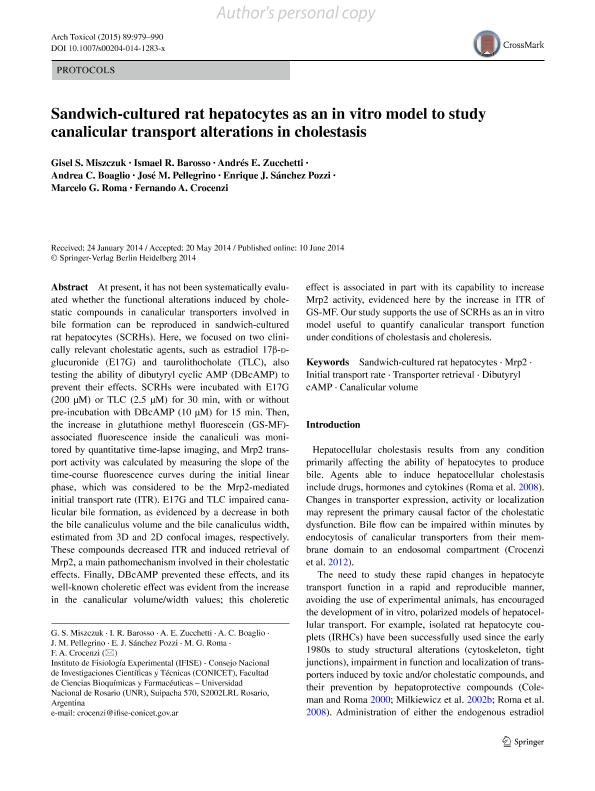Artículo
Sandwich-cultured rat hepatocytes as an in vitro model to study canalicular transport alterations in cholestasis
Miszczuk, Gisel Sabrina; Barosso, Ismael Ricardo ; Zucchetti, Andrés Ernesto
; Zucchetti, Andrés Ernesto ; Boaglio, Andrea Carolina
; Boaglio, Andrea Carolina ; Pellegrino, Jose Manuel
; Pellegrino, Jose Manuel ; Sanchez Pozzi, Enrique Juan
; Sanchez Pozzi, Enrique Juan ; Roma, Marcelo Gabriel
; Roma, Marcelo Gabriel ; Crocenzi, Fernando Ariel
; Crocenzi, Fernando Ariel
 ; Zucchetti, Andrés Ernesto
; Zucchetti, Andrés Ernesto ; Boaglio, Andrea Carolina
; Boaglio, Andrea Carolina ; Pellegrino, Jose Manuel
; Pellegrino, Jose Manuel ; Sanchez Pozzi, Enrique Juan
; Sanchez Pozzi, Enrique Juan ; Roma, Marcelo Gabriel
; Roma, Marcelo Gabriel ; Crocenzi, Fernando Ariel
; Crocenzi, Fernando Ariel
Fecha de publicación:
06/2014
Editorial:
Springer
Revista:
Archives of Toxicology
ISSN:
0340-5761
Idioma:
Inglés
Tipo de recurso:
Artículo publicado
Clasificación temática:
Resumen
At present, it has not been systematically evaluated whether the functional alterations induced by cholestatic compounds in canalicular transporters involved in bile formation can be reproduced in sandwich-cultured rat hepatocytes (SCRHs). Here, we focused on two clinically relevant cholestatic agents, such as estradiol 17β-dglucuronide (E17G) and taurolithocholate (TLC), also testing the ability of dibutyryl cyclic AMP (DBcAMP) to prevent their effects. SCRHs were incubated with E17G (200 μM) or TLC (2.5 μM) for 30 min, with or without pre-incubation with DBcAMP (10 μM) for 15 min. Then, he increase in glutathione methyl fluorescein (GS-MF)-associated fluorescence inside the canaliculi was monitored by quantitative time-lapse imaging, and Mrp2 transport activity was calculated by measuring the slope of the time-course fluorescence curves during the initial linear phase, which was considered to be the Mrp2-mediated initial transport rate (ITR). E17G and TLC impaired canalicular bile formation, as evidenced by a decrease in both the bile canaliculus volume and the bile canaliculus width, estimated from 3D and 2D confocal images, respectively. These compounds decreased ITR and induced retrieval of Mrp2, a main pathomechanism involved in their cholestatic effects. Finally, DBcAMP prevented these effects, and its well-known choleretic effect was evident from the increase in the canalicular volume/width values; this choleretic effect is associated in part with its capability to increase Mrp2 activity, evidenced here by the increase in ITR of GS-MF. Our study supports the use of SCRHs as an in vitro model useful to quantify canalicular transport function under conditions of cholestasis and choleresis.
Archivos asociados
Licencia
Identificadores
Colecciones
Articulos(IFISE)
Articulos de INST.DE FISIOLOGIA EXPERIMENTAL (I)
Articulos de INST.DE FISIOLOGIA EXPERIMENTAL (I)
Citación
Miszczuk, Gisel Sabrina; Barosso, Ismael Ricardo; Zucchetti, Andrés Ernesto; Boaglio, Andrea Carolina; Pellegrino, Jose Manuel; et al.; Sandwich-cultured rat hepatocytes as an in vitro model to study canalicular transport alterations in cholestasis; Springer; Archives of Toxicology; 89; 6; 6-2014; 979-990
Compartir
Altmétricas



